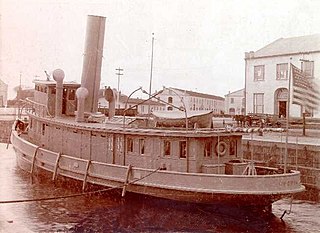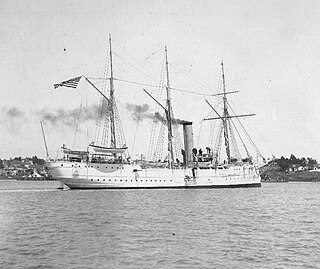
The United States Revenue Cutter Service was established by an act of Congress on 4 August 1790 as the Revenue-Marine upon the recommendation of Secretary of the Treasury Alexander Hamilton to serve as an armed customs enforcement service. As time passed, the service gradually gained missions either voluntarily or by legislation, including those of a military nature. It was generally referred to as the Revenue-Marine until 31 July 1894, when it was officially renamed the Revenue Cutter Service. The Revenue Cutter Service operated under the authority of the U.S. Department of the Treasury. On 28 January 1915, the service was merged by an act of Congress with the United States Life-Saving Service to form the United States Coast Guard.
USLHT Amaranth was a schooner-rigged, twin-screw, wooden-hulled lighthouse tender of United States Lighthouse Service, which served as a vessel of the United States Navy during World War I, and as part of the United States Coast Guard during World War II.

USS Bancroft was a United States Navy steel gunboat in commission from 1893 to 1898 and again from 1902 to 1905. She saw service during the Spanish–American War. After her U.S. Navy career, she was in commission in the United States Revenue Cutter Service from 1907 to 1915 as the revenue cutter USRC Itasca, and in the Revenue Cutter Service's successor service, the United States Coast Guard, as the cutter USCGC Itasca from 1915 to 1922. During her Coast Guard career, she saw service during World War I.

USRC Hudson, known for her service during the Battle of Cárdenas, was the United States Revenue Cutter Service's first vessel to have a steel hull and triple-expansion steam engine.

USS Coos Bay (AVP-25) was a United States Navy Barnegat-class small seaplane tender in commission from 1943 to 1946 that saw service during the latter half of World War II. After the war, she was in commission in the United States Coast Guard from 1949 to 1966 as the cutter USCGC Coos Bay (WAVP-376), later WHEC-376.

USS McCulloch, previously USRC McCulloch and USCGC McCulloch, was a ship that served as a United States Revenue Cutter Service cutter from 1897 to 1915, as a United States Coast Guard Cutter from 1915 to 1917, and as a United States Navy patrol vessel in 1917. She saw combat during the Spanish–American War during the Battle of Manila Bay and patrolled off the United States West Coast during World War I. In peacetime, she saw extensive service in the waters off the U.S. West Coast. She sank in 1917 after colliding with another steamer.

The second USS Suwannee and third USS Mayflower was a United States Lighthouse Board, and later United States Lighthouse Service, lighthouse tender transferred to the United States Navy in 1898 for service as an auxiliary cruiser during the Spanish–American War and from 1917 to 1919 for service as a patrol vessel during World War I. She also served the Lighthouse Board and in the Lighthouse Service as USLHT Mayflower from 1897 to 1898, from 1898 to 1917, and from 1919 to 1939, and in the United States Coast Guard as the first USCGC Mayflower (WAGL-236) in 1939 and from 1940 to 1943 and as USCGC Hydrangea (WAGL-236) from 1943 to 1945.
USLHT Azalea was an American lighthouse tender that operated in the fleet of the United States Lighthouse Board from 1891 to 1910 and of the United States Lighthouse Service from 1910 to 1917 and from 1919 to 1933. During and in the immediate aftermath of World War I, she served in the United States Navy as USS Azalea from 1917 to 1919. During World War II, she became the U.S. Navy seaplane tender USS Christiana (YAG-32) in 1942.

USS Half Moon (AVP-26) was a seaplane tender that in commission in the United States Navy from 1943 to 1946 that saw service in the latter half of World War II. After the war, she was in commission in the United States Coast Guard as the cutter USCGC Half Moon (WAVP-378), later WHEC-378, from 1948 to 1969, seeing service in the Vietnam War during her Coast Guard career.

The second USS Barataria (AVP-33) was a United States Navy Barnegat-class seaplane tender in commission from 1944 to 1946. She saw service in the later stages of World War II and was decommissioned postwar. She then was transferred to the United States Coast Guard and was in commission as the Coast Guard cutter USCGC Barataria (WAVP-381), later WHEC-381 from 1949 to 1969, serving in the Cuban Missile Crisis and the Vietnam War during her lengthy Coast Guard career.

USS Maple, was a lighthouse tender that served in the United States Navy from 1893 to 1899, seeing service as an auxiliary ship during the Spanish–American War in 1898, and from 1917 to 1919, operating as a patrol vessel during World War I. She also served as USLHT Maple in the United States Lighthouse Board fleet from 1899 to 1910 and in the United States Lighthouse Service from 1910 to 1933.
USCGC Mayflower may refer to more than one United States Coast Guard ship:

USLHT Armeria was a lighthouse tender in commission with the United States Lighthouse Board from December 1890 to March 1898. After Spanish–American War service in the United States Navy as USS Armeria from May to August 1898, she resumed her lighthouse tender duties, first with the Lighthouse Board from 1898 to 1910 and then with its successor organization, the United States Lighthouse Service, from 1910 until she was wrecked in 1912. She was the first lighthouse tender assigned to permanent duty in the Territory of Alaska.

USLHT Cedar was a lighthouse tender in commission in the fleet of the United States Lighthouse Service in 1917 and from 1919 to 1939, and – as USCGC Cedar (WAGL-207) – in the fleet of the United States Coast Guard from 1939 to 1950. She was in commissioned service in the United States Navy as the patrol vessel USS Cedar from 1917 to 1919 during and in the immediate aftermath of World War I. She also saw service in World War II under U.S. Navy control while in the Coast Guard fleet. She spent her career in the Pacific Northwest and the Territory of Alaska.

USLHT Camellia was a lighthouse tender in commission in the fleet of the United States Lighthouse Service from 1911 to 1917 and from 1919 to 1939, and – as USCGC Camellia (WAGL-206) – in the fleet of the United States Coast Guard from 1939 to 1947. During World War I she briefly saw war service with the United States Army in 1917 before serving as the United States Navy patrol vessel USS Camellia from 1917 to 1919. She also saw service in World War II under U.S. Navy control while in the Coast Guard fleet. After the conclusion of her United States Government career, she operated for decades in the service of the Dominican Navy as Capotillo.

USS Wompatuck (YT-27) was an armed tug in commission in the United States Navy from 1898 to 1931. Early in her naval career, she saw combat in the Spanish–American War and the Philippine–American War. After she was decommissioned, she was selected for conversion into the fuel oil barge YO-64, but she was lost in the early days of World War II in the Pacific before the conversion could be completed.
USCGC Alder (WAGL-216) was a wooden-hull lighthouse tender in commission in the fleet of the United States Lighthouse Service as USLHT Alder from 1924 to 1939, and in the fleet of the United States Coast Guard as USCGC Alder from 1939 until 1948. During World War II, she was given the additional designation (WAGL-216).
USCGC Hemlock (WAGL-217) was a lighthouse tender in commission in the fleet of the United States Lighthouse Service as USLHT Hemlock from 1934 to 1939, and in the fleet of the United States Coast Guard as USCGC Hemlock from 1939 to 1958. During World War II, she was given the additional designation (WAGL-217).

USCGC Elm(WAGL-260/WLI-72260) was an inland buoy tender used maintain aids to navigation by the United States Coast Guard.
USLHTBanahao was lighthouse tender that served in the Philippines.














